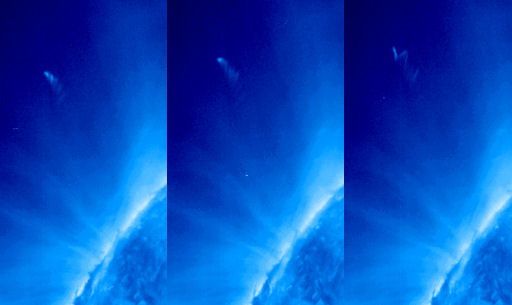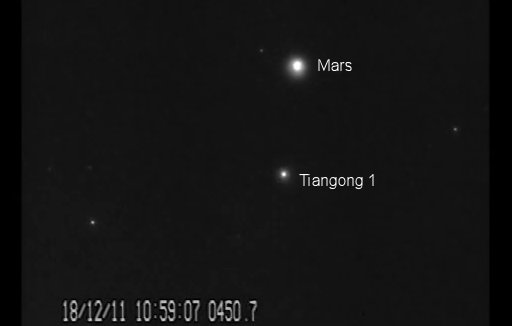COMET LOVEJOY IN THE MORNING: Noted astronomer John Bortle urges observers (especially in the southern hemisphere) to "begin searching for Comet Lovejoy's bright tail projecting up out of the morning twilight beginning at dawn. The tails of some of the major sungrazing comets have been extraordinarily bright. Comet Lovejoy's apparition has been so bizarre up to this point that it is truly difficult to anticipate just what might happen next ... [including] the exact sort of tail it might unfurl in the morning sky." [finder charts]
SPIRAL COMET TAIL: As Comet Lovejoy recedes intact from its Dec. 16th close encounter with the sun, researchers are pondering a mystery: What made the comet's tail wiggle so wildly in transit through the sun's atmosphere? The effect is clear in this sequence of extreme UV images recorded by NASA's STEREO-B spacecraft:
"Why the wiggles?" wonders Karl Battams of the Naval Research Lab. "We're not sure. There might be some kind of helical motion going on. Perhaps we're seeing material in the tail magnetically 'clinging' to coronal loops and moving with them. [Coronal loops are huge loops of magnetism that emerge from the sun's surface and thread the sun's atmosphere.] There are other possibilities too, and we will certainly investigate those!"
Battams notes that these images can be combined with similar images from STEREO-A on the other side of the sun to produce a three dimensional picture. "When we pair these together, and throw in the SDO images too, we should be able to get an incredibly unique 3-D picture of how this comet is reacting the the intense coronal heat and magnetic loops. We are going to learn a lot."
TIANGONG 1 AND MARS: This week, China's new space station, Tiangong 1, is making a series of bright passes through the morning skies of North America. On Dec. 18th, Kevin Fetter of Brockville, Canada, caught the 8.5-metric-ton spaceship flying past the planet Mars (video):
Tiangong 1 is unoccupied now, but China is planning to send Taikonauts to visit the experimental station at least once and possibly twice in 2012. To prepare for their arrival, last Thursday automated systems onboard Tiangong 1 began a series of air quality checks inside the station's 15-cubic meter pressurized volume.
Tiangong 1 is currently about as bright as the stars of the Big Dipper (a value that will approximately double when future spacecraft dock with it). To see it, check Spaceweather's Simple Satellite Tracker or your cell phone for local flyby times.

Solar wind
speed: 368.5 km/sec
density: 9.9 protons/cm3
explanation | more data
Updated: Today at 1357 UT
X-ray Solar Flares
6-hr max: B6 1258 UT Dec19
24-hr: B6 1258 UT Dec19
explanation | more data
Updated: Today at: 1300 UT
![]()
Daily Sun: 19 Dec 11
Sunspot complex 1381-1382 is growing rapidly. Credit: SDO/HMI
![]()
Sunspot number: 103
What is the sunspot number?
Updated 18 Dec 2011
Spotless Days
Current Stretch: 0 days
2011 total: 2 days (<1%)
2010 total: 51 days (14%)
2009 total: 260 days (71%)
Since 2004: 821 days
Typical Solar Min: 486 days
Updated 18 Dec 2011
The Radio Sun
10.7 cm flux: 128 sfu
explanation | more data
Updated 18 Dec 2011
![]()
Current Auroral Oval:
Switch to: Europe, USA, New Zealand, Antarctica
Credit: NOAA/POES
![]()
Planetary K-index
Now: Kp= 0 quiet
24-hr max: Kp= 1 quiet
explanation | more data
Interplanetary Mag. Field
Btotal: 5.7 nT
Bz: 0.9 nT north
explanation | more data
Updated: Today at 1357 UT
![]()
Coronal Holes: 19 Dec 11
There are no large coronal holes on the Earthside of the sun. Credit: SDO/AIA.





